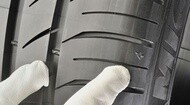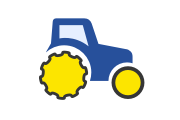Symptom: wear on both edges
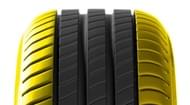
Diagnostic: underinflation
A tire is called underinflated when it doesn’t have sufficient air pressure to meet the vehicle manufacturer’s recommended psi (pressure per square inch). Underinflated tires lead to flats and tire blowouts.
Underinflation:
- reduces tread life through increased tread wear on the outside edges (or shoulders) of the tire
- generates excessive heat, which reduces tire durability and can lead to tire failure
- reduces fuel economy through increased rolling resistance (underinflated tires make your vehicle work harder)
Solution:
Add air to your tire until it reaches the proper air pressure (psi, as measured by an air pressure gauge).
Tire should be inspected by a Michelin tire dealer for source of air loss or signs damage due to underinflation.
To find the proper air pressure, consult your vehicle’s owner’s manual or find your recommended psi on the sticker on your door jamb.
Symptom: wear in centre and excessive wear
Diagnostic: overinflation
- On an overinflated tire, the centre of the tread bears most of the load and wears out faster than the outside edges.
- To prevent overinflation, always check tires when they’re cold, before they’ve been driven on or at least three hours after.
Solution:
Adjust inflation pressure using a tire pressure gauge when tires are cold and before they are driven on. To find the proper air pressure, consult your vehicle’s owner’s manual or find your recommended psi on the sticker on your door.
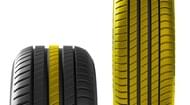
Symptom: uneven wear
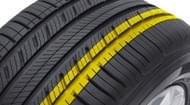
Diagnostic 1: poor alignment
- Uneven front or rear tire wear means you need an alignment.
- Changes in your vehicle's handling or steering response (e.g., pulling to one side).
Solution:
Many vehicles today are equipped with rear suspensions that can be adjusted for alignment. If this is the case, your vehicle may need a "front end" alignment or a "four wheel" alignment, depending on the symptoms you are experiencing. See your local Michelin authorized tire dealer for service and inspection.
Diagnostic 2: overinflation issues
- On an overinflated tire, the centre of the tread bears most of the load and wears out faster than the outside edges.
- To prevent overinflation, always check tires when they’re cold, before they’ve been driven on or at least three hours after.
Solution:
Adjust inflation pressure using a tire pressure gauge when tires are cold and before they are driven on. To find the proper air pressure, consult your vehicle’s owner’s manual or find your recommended psi on the sticker on your door jamb.
Symptom: scalloped
Diagnostic 1: poor alignment
You need an alignment when you notice:
- Uneven front or rear tire wear means you may need an alignment.
- Changes in your vehicle's handling or steering response (e.g., pulling to one side).
Solution:
Many vehicles today are equipped with rear suspensions that can be adjusted for alignment. If this is the case, your vehicle may need a "front end" alignment or a "four wheel" alignment, depending on the symptoms you are experiencing. See your local Michelin authorized tire dealer for service and inspection.
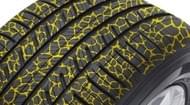
Diagnostic 2: overinflation
- On an overinflated tire, the centre of the tread bears most of the load and wears out faster than the outside edges.
- To prevent overinflation, always check tires when they’re cold, before they’ve been driven on or at least three hours after.
Solution:
Adjust inflation pressure using a tire pressure gauge when tires are cold and before they are driven on. To find the proper air pressure, consult your vehicle’s owner’s manual or find your recommended psi on the sticker on your door.
Symptom: sawtooth edges and feathered edges
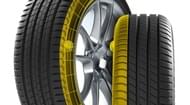
Diagnostic: misalignment
If a vehicle is misaligned, the edges of the tread have a sawtooth or feathered appearance. This is caused by erratic scrubbing against the road.
Solution:
Your car most likely needs an alignment correction. Please see your local authorized Michelin tire dealer for inspection.
Symptoms: dips and cups
Diagnostic: worn parts
- Cupping can be attributed to bent or worn suspension parts, wheel misalignment, an imbalance of the tire/wheel assembly, etc. Once this type of wear pattern has occurred, it is irreversible and the tires will continue to wear unevenly.
- However, rear tires can cup as well.
Solution:
Worn parts may be a sign that wheels are out of balance or that suspension or steering system parts need service or replacement. Please see your local authorized Michelin retailer for inspection.
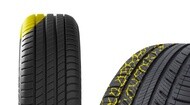
Symptom: damage
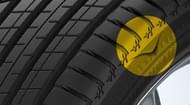
Diagnostic: tire damage that requires repair
If your tire becomes damaged, it may be repaired if it meets the following criteria:
- The tire has not been driven on when flat
- The damage is only on the tread section of your tire (sidewall damage ruins a tire immediately) and/or
- the puncture is no greater than 6 mm (¼").
Solution:
The proper way to have a tire repaired is to patch the tire from the inside and fill the puncture hole. Do not have your tire plugged. Ever. Plug repairs do not involve taking the tire off the wheel for a proper inspection. A plug is simply inserted into the punctured area, making it unreliable. Insist on a full inspection and have your dealer demount and internally as well as externally inspect the tire, patch and fill the repair on the inside of the tire.
Symptom: bar across tread
Diagnostic: worn-out tire
- All tires have tread wear indicator bars at 1,6 mm (2/32") of remaining tread.
- When the tread is worn down to 1,6 mm (2/32") or when you can see the tread wear indicator bars on any section of the tire, the tire is worn out and should be replaced.
Solution:
Take your vehicle to an authorized Michelin retailer for an inspection and have a professional measure the remaining tread with a tread depth gauge.
